

Barolo Tour 2011 - Gaja
English version
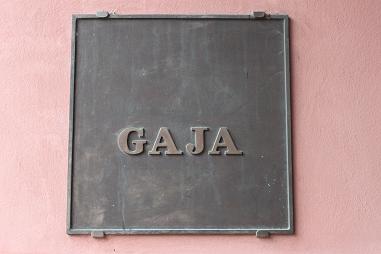
Our visit at Gaja in Barbaresco in november 2011 was our second during the last three years.
We had an appointment with Sonia Franco, personal assistent to Angela Gaja, and one of the kindest younger women in the area. Sonia Franco was also the woman behind our last visit in 2009.
We still remember the first visit. After a little tour in the cellar, we were presented with some of the wines from the large range from Gaja. A very nice tasting.
During the tour Thomas asked some very specific questions about labels, prior history of Gaja and more. Sonia was able to answer these questions but somehow these questions must have made some kind of impression because 15 minuttes into the tasting Angelo Gaja suddenly stood in the door welcoming us with open arms and lots of time to answer any question we might have.
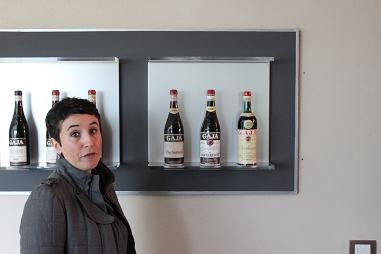
We had 1½ hour together with Angelo Gaja back in 2009 talking about wine, the nessesary effort to convience the younger generation about the culture and identity of Italian wine to insure that the younger generation keeps drinking wine dispite the ongoing effort from many european countries to convince us all about the bad things that will happen to us, if we continue to drink alcohol. Yes, wine is also alcohol, but alcohol together with a lot of other good components.
This time Gaja and his wife was away on a business trip, so we had Sonia all to ourselves....
We had the chance to see the new cellar. Very nice! If you wonder why we don't present you with pictures, it's because we were not allowed to take any pictures in the cellar. Perhaps the only place in the area, where that is forbidden....
To the right you can see Sonia in front of some of the old bottles!
Before we go any further let us concentrate on the history of the Gaja estate from the beginning to modern times, and there is a lot of ground to cover! Angelo Gaja is truly the most important wine producer in the area and perhaps in the entire country. Here, there, everywhere - but never outside Italy though he came close in the late 1980'es with Robert Mondavi in Napa Valley.
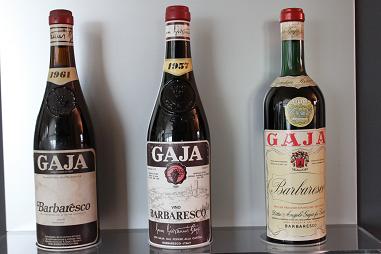 The Gaja estate was founded in 1859 by Giovanni Gaja. The Gaja family having arrived from Spain during the 17th century. The family Gaja opened a tavern in Barbaresco, serving its wines with the food. At the end of the 19th century, Gaja wines were bottled and supplied to the Italian army in Abyssinia.
The Gaja estate was founded in 1859 by Giovanni Gaja. The Gaja family having arrived from Spain during the 17th century. The family Gaja opened a tavern in Barbaresco, serving its wines with the food. At the end of the 19th century, Gaja wines were bottled and supplied to the Italian army in Abyssinia.In 1937, Giovanni Gaja first put the name Gaja in big red letters on labels. The firm progressed following World War II as Giovanni Gaja made a significant series of vineyard purchases in terms of scale and vineyard quality. Also cited as an important influence to the firm's early success is the mother of Giovanni Gaja, Clotilda Rey, who instilled the principles of working to achieve high quality to attract the desired clientele, and set high prices to manifest the prestige of the product.
Angelo Gaja, born in 1940, is the great-grandson of Giovanni Gaja. Angelo Gaja began his career with the company in 1961 at the age of 21, having studied wine making at the Enological Institute in Alba and at the University of Montpellier in France, and held a degree in economics from the University of Turin. At the time there were only about 100 people producing Barbaresco and Barolo, and Gaja was already the major vineyard owner of Barbaresco.
Following several trips to France and disputes with his father, Angelo Gaja introduced several practices to the region over the following years, revolutionary to the vinification of Nebbiolo. From 1961 began the first experiments with green harvest or diradamento, and single vineyard production was started with Sorà San Lorenzo in 1967, Sorà Tilden in 1970 and Costa Russi in 1978. Since 1970 Gaja has employed the eminent oenologist Guido Rivella. Gaja is also credited with introducing to Piemonte malolactic fermentation, from the 1975–1976 vintage implementing French barriques ten years after initial experiments, bringing in thermo-controllable fermentation equipment and French grape varieties, and eventually grand cru prices. Giovanni Gaja opposed his son's use of new barriques and the decision to plant French grape varieties.
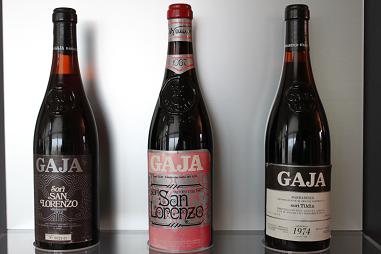
In 1978 the Darmagi vineyard in Barbaresco, a prime Nebbiolo site, was planted with Cabernet Sauvignon. This was followed in 1979 when The Gaia & Rey vineyard in Treiso was planted with Chardonnay. Later in 1983, Sauvignon Blanc was planted in the Alteni di Brassica vineyard in Barbaresco.
Even though is considered a modernist, he uses barrique in a restricted fashion. Gaja ferments his wines for up to 30 days, the old-fashioned way instead of the modernist five-day fermentations, and although he employs barriques for the first year of aging, the process is finished in big botti, 10-100 hectoliters, some of which is 80–120 years old. Piemonte producers who became inspired by Gaja's methods include Renato Ratti and Aldo Conterno.
Perhaps you can now understand why the personal meeting with Gaja in 2009 was so big for us? But wait - there is musch more.....
During the 1980'es Gaja achieved god-like status among international journalists. No matter what, Gaja couldn't set a foot wrong in any way.
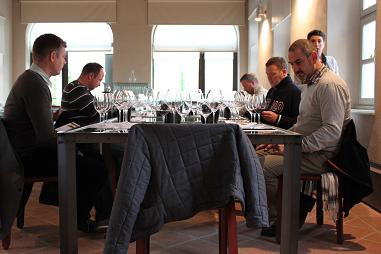 In 1988 Gaja returned to Barolo with the acquisition of 28 hectors of property, having previously rented vineyards there and then discontinued the activity when the strategy called for focus on self-owned single vineyards. The Barolo Sperss was first released in 1992. Further acquisitions saw Gaja own property in Montalcino, Tuscany with the Pieve Santa Restituta estate in 1994, Gromis property in La Morra for the production of Barolo Conteisa Cerequio in 1995 and the Ca'Marcanda property in Bolgheri, Tuscany, in 1996.
In 1988 Gaja returned to Barolo with the acquisition of 28 hectors of property, having previously rented vineyards there and then discontinued the activity when the strategy called for focus on self-owned single vineyards. The Barolo Sperss was first released in 1992. Further acquisitions saw Gaja own property in Montalcino, Tuscany with the Pieve Santa Restituta estate in 1994, Gromis property in La Morra for the production of Barolo Conteisa Cerequio in 1995 and the Ca'Marcanda property in Bolgheri, Tuscany, in 1996.A major change happend in 1996, where Gaja declassified all his DOCG Barolo and Barbareco wines, except for one, the Barbaresco DOCG. Some said it was because Gaja wanted to blend a little percentage of international grapes into the wine, which is not allowed in the DOCG (100% Nebbiolo). Gaja denied and stated that it was because he wanted to add a little percentage of Barbera grapes into the wine as a "correction for acidity". That is not allowed either, so these wines are now under the Langhe Rosso appellation.
As a result of "the mix" these wines grew in prestige, and the only remaining Barbaresco was suddenly referred to as "the standard wine". This was not a fortunate moment for Angelo Gaja, who have been making Barbaresco the classic way since the mid 1850'es.
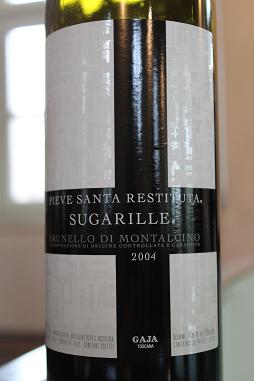 Angelo Gaja is now 71 years old but not yet officially retired. But his daughters Gaia and Rossana is running the business on daily basis. If you ask us, it's no secret who makes the decissions even here in 2012. Angelo Gaja is still the patriarc at the end of the table :-)
Angelo Gaja is now 71 years old but not yet officially retired. But his daughters Gaia and Rossana is running the business on daily basis. If you ask us, it's no secret who makes the decissions even here in 2012. Angelo Gaja is still the patriarc at the end of the table :-)In modern time Gaja has properties in Barolo, Barbaresco, Montalcino and Bolgheri. It is in total around 240 hectars - 100 in Piedmont and 140 in Tuscany.
Here is the large range of different wines:
Barbaresco
Gaja Barbaresco DOCG
Costa Russi
Sorì Tildìn
Sorì San Lorenzo
Barolo
Sperss
Conteisa (Conteisa Cerequio)
Dagromis
Darmagi
Sito Moresco
Alteni di Brassica
Rossj-Bass
Grappa
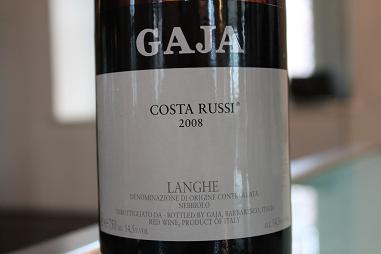
Tuscany
Pieve Santa Restituta
Rennina
Sugarille
Ca'Marcanda
Promis
Magari
Camarcanda
Sonia Franco had arranged a fine wine tasting in the special tasting room. Lots of glasses for all of us, lovely. Nice to have the opportunity to have several glasses, som you can switch between the wines and compare.
Before the tasting we had a little talk with Sonia about what had been going on at Gaja's since our last visit in 2009. Of course this is kind of a silly question due to the fact that Gaja is always on the move, always in the front line, always trying to improve quality in their wines.
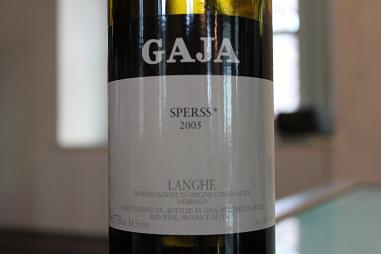
As you can read above, one of the bravest moves in the past was the decission to step out of the DOCG and "just" make Langhe Rosso DOC to let a little Barbera grapes into the wines or perhaps the combination of barrique and long fermentation or even the combination of barrique ½ of the ageing time and then put the wine into big barrels??
Perhaps the beginning of green harvest in 1961! or plant Cabernet Sauvignon in a Nebbiolo vineyard in 1978 (Darmagi)?
Close to modern time in the late 1990'es the big news was to expand the business to Montalcino and Bolgheri. As you will see, if you read our wine notes beneath, the wines from the middle of Italy is the same high standard as in the north and among the best in the areas. After a relatively short period of time. Impressive!!
But the fact remains, that Angelo Gaja always stays in the front of developing the area, the way of making wines, the commercial side of Italian winemaking etc.
This is the obvious reason why Angelo Gaja have had and still has this icon status in Italy. When Gaja speaks, people listen. We specially remember the time back in the late 1980'es where Angelo Gaja was just about to involve himself into a joint venture with Robert Mondavi. In the last minut Gaja decided, that this would be a mistake to go on the American market. He said "it's like a mosquito having sex with an elephant - very dangerous and not much pleasure".
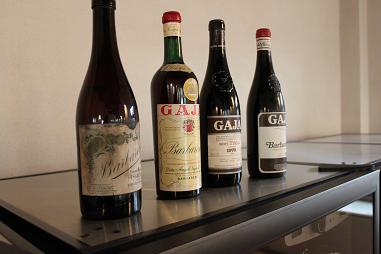
Back to the wine tasting. We were presented to the following wines. If you want to see our review of a particulary wine or more, just click on the wine, and you'll be forwarded to our wine database with almost 5.000 Italian wine reviews:
Toscana Magari 2009, Gaja
Bolgheri Camarcanda 2007, Gaja
Brunello di Montalcino Sugarille 2004, Gaja
Barolo Dagromis 2006, Gaja
Barbaresco 2008, Gaja
Langhe Nebbiolo Costa Russi 2008, Gaja
Langhe Nebbiolo Sperss 2005, Gaja
It is obvious to anybody who have tasted the wines from Gaja that the quality is second to none! No matter if you taste the wines from the Pieve Santa Restituta estate in Montalcino, the Ca'Marcanda estate in Bolgheri or wines from the well known estate in Barbaresco, you will always taste prime quality.
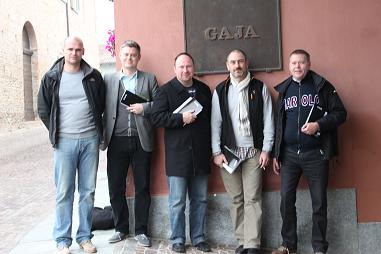
There is only one downside to this - the prices are very high. Still affordable if you buy the tuscan wines, but not affordable wines for everybody, if you think of the wines from Piedmont.
Many people ask about the ageing potential in Gaja wines. It's very high. We have tasted several of the big wines at the age of 10 or 15 years - still not mature. The best vintages can keep for decades and keeps getting better and become more and more aristokrati and complex.
It's always nice to visit Gaja in Barbaresco. The nicest company around Sonia and some of the best wines in Italy, but all good things come to an end - also on this day in november 2011. After a couple of very pleasent hours we said goodbye to Sonia and headed back to Barolo for more visits in the area.
The last thing to do was the traditional group photo in front of the Gaja estate in Barbaresco.
You can find the wines from Gaja in many wine shops in Denmark.
Copyright 2012
Vinhulen.dk